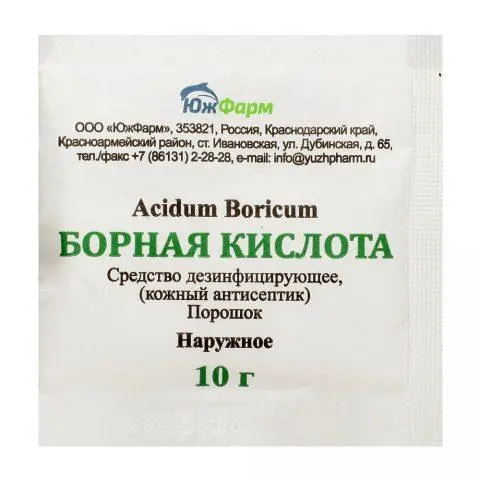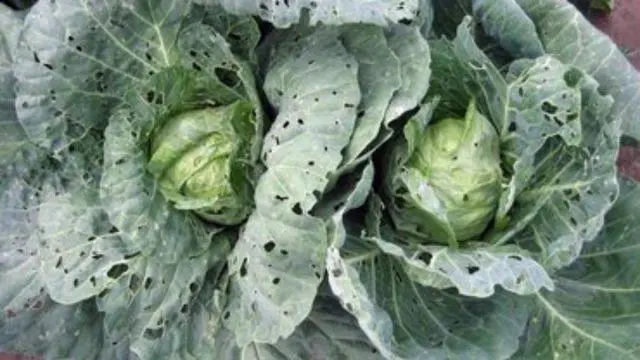Contents
Boric acid for cabbage can be used several times per season. The main purpose is the accelerated formation of ovaries and increased yields. Also, the substance is used as a growth stimulator – seeds are soaked in a weak solution overnight. Acid can also be used as a means of pest prevention. The drug is sold in the form of a powder, you can buy it at a pharmacy (without a prescription) or in a store for summer residents.
The benefits of boric acid for cabbage
Feeding cabbage with boric acid is recommended for various reasons. Boron is a trace element that is required by plants in small amounts, but it plays an important role:
- absorption of nitrogen compounds;
- growth processes;
- improving the taste of cabbage;
- stimulation of the formation of ovaries;
- prevention of diseases – fungal, bacterial;
- destruction of aphids and ants;
- increasing the resistance of cabbage to adverse weather conditions, infectious diseases and pests;
- increase in keeping quality.
Due to boron deficiency, cabbage develops worse, growth processes slow down. The ovaries are formed in smaller quantities, and therefore the yield is reduced. In general, plants become weakened, lose their resistance to disease and weather. If there is practically no boron in the soil, weakened seedlings may die.
Boric acid is produced in the form of a white powder. It is sparingly soluble in water, so a hot liquid must be prepared first. Sometimes you can find acid in tablets. This is a less convenient form of release, since you first need to recalculate the amount per pure substance. Therefore, it is better to purchase powder.
You can also treat cabbage and other plants with drugs such as Mag-Bor, Organo-Bor or Borofoska. They must be used strictly according to the instructions, since an excess of boron is no less dangerous for cabbage than its deficiency. Means are diluted in water in the right amount and then watered under the root. Foliar top dressing (spraying) is also carried out.

The powder can be bought at the pharmacy without a prescription.
Signs of a Boron Deficiency
It is especially important to treat cabbage with boric acid during the period when signs of a lack of this trace element are found:
- The leaf plate is swollen, shaped like a dome.
- Young foliage is covered with spots resembling burns.
- Leaves and shoots lose their normal shape, some of them are bent.
- Growth points die off, so cabbage develops more slowly.
- Areas of necrosis form on leaves and shoots, they die off and fall off.
- The foliage becomes thinner, can break from a weak impact.
- Rust is visible on the surface of the stem.
- Cabbage heads are formed more slowly.
How to dilute boric acid for processing cabbage
Before using boric acid for cauliflower and other varieties of cabbage, it is necessary to prepare a solution. You need to act like this:
- Prepare a small amount of hot, but not boiling water.
- Measure the required amount of powder, for example 2,0 g.
- Pour into water and mix thoroughly until completely dissolved.
- Bring to a total volume of 10 liters and mix again.
- Water the beds or pour into a sprayer and start processing.
How to use boric acid for processing cabbage
Boric acid for cabbage is used in various ways. It can be used for seed treatment, soil irrigation, as well as foliar application. The main applications are detailed below.
seed Processing
For seed treatment, a solution of a standard concentration of 2 g per 10 liters is prepared. Since a smaller volume is usually required, it is reduced by a factor of 10 – they take 0,2 g of powder per 1 liter. Measurements must be carried out using a kitchen scale with an accuracy of tenths or hundredths.
Seeds are preliminarily laid out in one layer and small ones are rejected, with damage and deformation. Then put in a saline solution (1 tablespoon per 1 liter of water) and remove those that float. Immerse in a solution of boric acid at room temperature and leave for 12-24 hours. Immediately after that, they start landing.
Soil watering
One of the main uses is to pour cabbage with boric acid, i.e. apply root dressing. If there are clear signs of a lack of boron, described above, you should prepare a solution of 2 g per 10 liters and water the plants under the root (500 ml for each specimen).

Before transplanting, the soil is treated with boric acid
The same composition can moisten the soil. Fluid consumption – 10 l per 10 m2. Thus, 1,5-2 liters is enough for a small bed.
Foliar top dressing
Along with watering the cabbage, spraying with boric acid is also carried out. As soon as heads begin to form, a solution of a reduced concentration of 10 g per 10 l or 1 g per 1 liter is prepared. Then pour into a spray bottle and spray each plant. The procedure is recommended to be repeated 2-3 times per season with an interval of 10 days.
Simultaneously with boron, other preparations are introduced foliarly. If you use them together, the concentration is recommended to be reduced by 2 times – i.e. 5 g per 10 liters or 0,5 g per 1 liter.
Spraying under the root
You can also spray cabbage with boric acid under the root. This is an optional procedure – it is carried out only if clear signs of boron deficiency are found. For work, a solution of a standard concentration of 2 g per 10 l or 0,2 g per 1 liter is prepared. In the evening or early morning sprayed under the root. Usually this is quite enough to make up for the lack of trace elements.
Pest Control
The drug can also be used to control cabbage pests (fleas, moths, aphids and others). There are quite a few recipes, the most effective are:
- Spread the powder in a small layer along the beds and in places where ants accumulate.
- Dissolve 50 g of sugar and 5 g of boric acid in 100 ml of hot water, cool and pour along the beds.
- Grind two boiled yolks with 5 g of powder, roll up peas and scatter around the beds.
- Boil three potatoes, mix with two boiled yolks, add powder and sugar (10 g each). Roll into balls and place in places where insects accumulate.

Boric acid is used to prevent insect infestation
Safety measures
Means belongs to the 3rd class of toxicity (low hazardous substance). Boric acid is practically harmless to humans, plants and pollinators. In addition, the concentration of the solution is very low, so it does not pose a danger.
You can work with liquid without special protective equipment. But it is advisable to take the powder itself with a spoon, put on gloves, eliminating direct contact with the skin. Do not allow the solution to enter the stomach, into the eyes. During work, exclude children from access, do not eat and drink.
It is also recommended to spray cabbage in the early morning or late evening. If you do this on a sunny day, the leaves will get burned. Because of this, the growth rate will slow down.
Conclusion
Boric acid for cabbage is one of the most important top dressings, without which the ovaries will not form so actively. Boron plays an important role, it provides growth processes, improves the taste of fruits and increases yield. Therefore, during one season, it is recommended to carry out at least two top dressings – watering under the root and spraying the plants.










